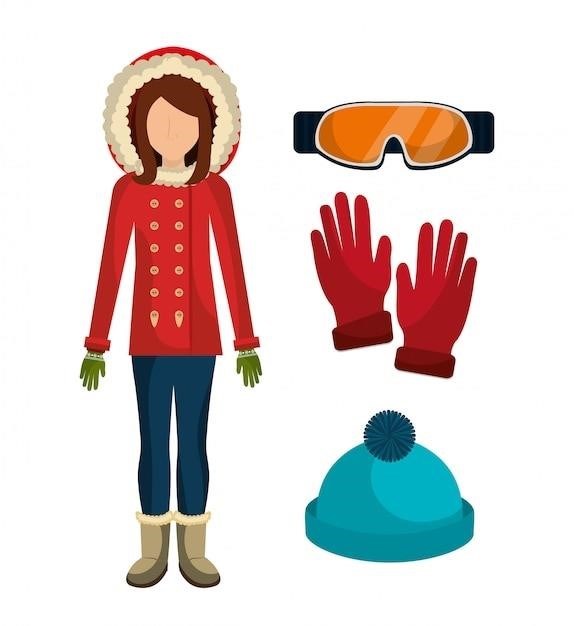Snow Goggle Lens Color Guide⁚ Choosing the Right Tint for Every Condition
Choosing the right snow goggle lens tint can make a world of difference in your skiing or snowboarding experience․ This guide will break down the best lens tints and features for various light conditions, helping you find the perfect goggles for every adventure․
Understanding Lens Tint and VLT
Lens tint refers to the color of the lens, which affects the amount of light that passes through it․ This is measured by Visible Light Transmission (VLT), a percentage that indicates how much light is allowed to pass through the lens․ A higher VLT percentage means more light passes through, making the lens lighter, while a lower VLT percentage means less light passes through, making the lens darker․
VLT is crucial in choosing the right lens for different light conditions․ For example, a dark lens with a low VLT is ideal for bright sunny days, while a lighter lens with a higher VLT is better for overcast or low-light conditions․ Understanding the relationship between lens tint and VLT will help you select the right lens for optimal visibility and comfort․
Here’s a general breakdown of VLT percentages and their suitability for different light conditions⁚
- High VLT (60-80%)⁚ Best for low-light conditions like cloudy days, early mornings, or late afternoons․
- Medium VLT (40-60%)⁚ Versatile for a range of conditions, from partly cloudy to sunny days․
- Low VLT (20-40%)⁚ Ideal for bright sunny days or high-altitude skiing․
- Very Low VLT (0-20%)⁚ Suitable for extreme glare and bright sunlight, often found in high-altitude environments․
By considering VLT percentages and lens tint, you can choose the right snow goggle lens for optimal performance and safety in any weather condition․
The Importance of UV Protection

UV protection is crucial when it comes to snow goggle lenses․ Snow reflects a significant amount of UV rays, which can damage your eyes and lead to various health problems․ UV rays are invisible to the naked eye, so it’s essential to have goggles that offer adequate protection․
All good quality ski goggle lenses are certified to block out 100% of harmful UVA and UVB rays․ This means the lenses will filter out all ultraviolet radiation, safeguarding your eyes from potential damage․ You should always check the label of your goggles to confirm that they provide this level of protection․
Skiing or snowboarding without UV protection can lead to various eye conditions, including⁚
- Photokeratitis (Snow Blindness)⁚ This painful condition occurs when the cornea is damaged by excessive UV exposure, causing temporary vision loss and sensitivity to light․
- Cataracts⁚ Long-term exposure to UV radiation can contribute to the development of cataracts, which are clouding of the eye lens that can affect vision․
- Macular Degeneration⁚ This age-related eye disease can be aggravated by UV exposure, leading to central vision loss․
By choosing goggles with 100% UV protection, you can protect your eyes from these harmful effects and enjoy your time on the slopes safely․
Choosing the Right Lens for Sunny Conditions
When the sun is blazing on the mountain, you need lenses that can effectively reduce glare and provide clear vision․ The best lenses for bright conditions are those with a dark tint, such as dark grey, dark brown, or dark rose, often paired with a heavy mirror coating․ These lenses help to filter out excessive light, making it easier to see details on the snow․
A dark grey lens offers a neutral color perception, reducing glare and making it easier to see subtle changes in terrain․ Dark brown lenses, on the other hand, enhance contrast, allowing you to see details more clearly in both bright and shadowed areas․ Dark rose lenses, known for their ability to boost color perception, are particularly good at cutting through haze and improving visibility in snowy conditions․
A mirror coating on the lens further enhances protection by reflecting away glare․ A solid mirror coating, like a silver or gold mirror, helps deflect the sun’s rays, reducing eye strain and improving comfort․ While dark lenses and mirror coatings offer excellent protection in sunny conditions, it’s important to note that they may not be suitable for overcast or low-light conditions․
Remember, the ideal lens tint for sunny conditions is one that provides a balance between glare reduction, contrast enhancement, and comfort․ Experiment with different tints and find the one that works best for your individual needs․
Best Lenses for Overcast and Flat Light
Overcast and flat light conditions can present a challenge for skiers and snowboarders, as the lack of direct sunlight can make it difficult to see terrain features and depth perception․ To overcome this, you need lenses that enhance contrast and boost light transmission․ Yellow, amber, or rose-colored lenses are excellent choices for these conditions․
Yellow lenses are particularly effective at filtering out blue light, which can create a hazy effect in overcast conditions․ They enhance contrast, allowing you to see details more clearly, and improve depth perception, making it easier to judge distances and navigate uneven terrain․ Amber lenses, similar to yellow, also enhance contrast and boost light transmission, making them ideal for overcast days․
Rose-colored lenses, often referred to as “rose gold,” offer a warm hue that enhances visibility in flat light conditions․ They help to cut through haze and improve contrast, allowing you to see details more clearly․ While yellow, amber, and rose lenses are great options for overcast and flat light, they may not be suitable for bright sunny conditions․
Ultimately, the best lens tint for overcast and flat light conditions is a matter of personal preference․ Experiment with different tints and find the one that provides the best visibility and comfort for your individual needs․
Lens Colors for Low Light and Night Skiing
When the sun starts to set or you’re skiing under the moonlight, you need lenses that maximize light transmission and enhance visibility in low-light conditions․ Yellow, amber, or even clear lenses are your best bet for night skiing and low-light situations․
Yellow lenses, as mentioned earlier, are excellent at filtering out blue light and enhancing contrast, which is crucial for seeing details in low-light conditions․ They allow more light to pass through, improving visibility and making it easier to navigate the slopes․ Amber lenses also enhance contrast and offer a warm hue that can be beneficial in low-light settings․
Clear lenses, while offering the least amount of tint, are often the best option for very low light situations, such as night skiing under a full moon․ They allow the most light to pass through, maximizing visibility․ Some goggles feature photochromic lenses, which automatically darken in bright light and lighten in low-light conditions, offering versatility across various lighting scenarios․
When choosing lenses for low light and night skiing, consider the specific conditions you’ll be skiing in․ If you’re skiing under a full moon, clear lenses may be the best choice․ However, if it’s a cloudy night or the moon is obscured, yellow or amber lenses will provide better visibility․ Remember, safety is paramount, so prioritize lenses that offer the best visibility for the conditions you’ll be skiing in․
Understanding Mirror Coatings
Mirror coatings, often found on snow goggle lenses, serve a dual purpose⁚ to reduce glare and enhance visual clarity․ They work by reflecting a portion of incoming light, minimizing the amount of light that reaches your eyes․ This is particularly beneficial in bright, sunny conditions where glare can be a major issue, causing eye strain and discomfort․
The color of the mirror coating often influences the amount of light it reflects․ Darker mirror coatings, such as silver, blue, or red, reflect more light and are ideal for extremely bright conditions․ Lighter mirror coatings, like gold or amber, reflect less light and are better suited for moderately sunny days or overcast conditions․ Mirror coatings can also enhance contrast, making it easier to see details in various lighting conditions․
Some mirror coatings have additional features, such as anti-fog treatments, that further enhance performance․ Anti-fog coatings help prevent fogging, ensuring clear vision even in humid or damp conditions․ It’s essential to choose a mirror coating that complements the lens tint and meets your specific needs․ If you’re skiing in bright, sunny conditions, a darker mirror coating might be preferable, while a lighter mirror coating might be better for overcast or moderately sunny days․
Remember, the goal is to find a mirror coating that enhances your visual experience, reduces glare, and allows you to see clearly in various lighting conditions․ Consider the specific conditions you’ll be skiing in and choose a mirror coating that complements the lens tint and offers the best protection and clarity․
Choosing the Right Lens for Your Specific Needs
Determining the ideal snow goggle lens for your specific needs involves considering various factors, including the primary conditions you’ll be skiing in, the time of day, and your personal preferences․ If you primarily ski on sunny days, dark lenses with a high VLT (Visible Light Transmission) are ideal for reducing glare and enhancing contrast․ For overcast days or low-light conditions, lighter lenses with a lower VLT allow more light to pass through, improving visibility in dim environments․
A good rule of thumb is to choose a lens that is one shade darker than your normal sunglasses for bright sunny days and one shade lighter for overcast days․ Consider using goggles with interchangeable lenses for optimal versatility․ This allows you to easily swap lenses depending on the light conditions, ensuring optimal visibility throughout the day․ If you frequently ski in a variety of conditions, a versatile lens tint, like a medium copper or rose, can be a good option․
For those who primarily ski in flat light conditions, yellow or rose-colored lenses are excellent choices, as they enhance contrast and help you see the terrain more clearly․ If you often ski at night or in very low-light conditions, consider lenses with a high VLT or even a night-vision lens․ It’s essential to prioritize safety and ensure you can see clearly regardless of the lighting conditions․ Remember, choosing the right lens is crucial for a safe and enjoyable skiing experience․
Additional Lens Features to Consider
While lens tint is crucial, several other features can significantly enhance your snow goggle experience․ Anti-fog coating is essential for preventing fog buildup, especially during strenuous activity or when temperatures fluctuate․ Look for lenses with a hydrophobic coating that repels water, preventing condensation and ensuring clear vision․ Consider polarized lenses, which reduce glare from reflective surfaces like snow and water, enhancing visual clarity and reducing eye strain․
For those seeking enhanced clarity and detail, explore lenses with technologies like ChromaPop, which enhances color contrast and allows you to see details more vividly․ Some lenses offer photochromic technology, which automatically adjusts tint levels based on light intensity, providing optimal vision in varying conditions․ Remember, these additional features are not mandatory, but they can significantly improve your goggle performance and comfort․
When selecting lenses, consider the type of frame you’ll be using․ Some goggles offer interchangeable lenses, allowing you to switch between different tints and features depending on the weather and conditions․ Ultimately, the best lens for you depends on your individual needs, preferences, and the types of skiing or snowboarding you enjoy․ Investing in high-quality lenses with additional features can make a significant difference in your overall experience and safety on the slopes;
Maintaining Your Snow Goggles
Proper care ensures your snow goggles remain in optimal condition, delivering peak performance and lasting longer․ Always store your goggles in a protective case when not in use, preventing scratches and damage․ Avoid exposing your goggles to extreme temperatures, as this can affect the lens coatings and potentially damage the frame․ Clean your lenses regularly with a microfiber cloth specifically designed for cleaning optics․ Avoid using harsh chemicals or abrasive materials that can scratch the lens surface․

If your lenses become foggy, gently wipe them with a microfiber cloth or use a dedicated anti-fog solution․ Never rub the lenses with your hands or a dry cloth, as this can create scratches․ For stubborn dirt or debris, carefully rinse your goggles with clean water and gently wipe with a microfiber cloth․ If you need to remove the lens for cleaning, handle it with care, ensuring that you do not scratch or damage the frame or lens․ Avoid dropping or exposing your goggles to excessive force․
Proper maintenance ensures your snow goggles remain in prime condition, providing clear vision and protecting your eyes for many seasons to come; By following these simple tips, you can extend the life of your goggles and enjoy optimal performance on the slopes․


